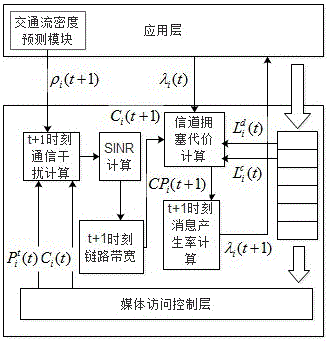Adaptive rate control method based on mobility and DSRC/WAVE network relevance feedback
A related feedback and rate control technology, applied in the field of Internet of Vehicles communication, can solve the problems of no consideration of impact, high time complexity, and only control congestion, etc., and achieve the effect of small queuing delay, accurate control target, and accurate detection results.
- Summary
- Abstract
- Description
- Claims
- Application Information
AI Technical Summary
Problems solved by technology
Method used
Image
Examples
Embodiment Construction
[0037] This embodiment provides an adaptive rate control method for mobility and DSRC / WAVE network-related feedback, which mainly includes a traffic flow density prediction module, a communication interference calculation module at time t+1, a SINR calculation module, and a link at time t+1. Bandwidth calculation module, channel congestion cost calculation module and adaptive message generation rate calculation module, such as figure 1 As shown, its specific implementation is as follows:
[0038] The traffic flow density prediction module estimates the traffic flow density from a macro perspective, and regards the traffic flow as an evolving whole, making it easier to calculate the average density of vehicles. Each vehicle in the road traffic environment simplifies the change law of speed and time into a partial differential equation according to its own speed and road congestion density in the free flow state, combined with the fluid mechanics model, traffic flow theory and ...
PUM
 Login to View More
Login to View More Abstract
Description
Claims
Application Information
 Login to View More
Login to View More - R&D
- Intellectual Property
- Life Sciences
- Materials
- Tech Scout
- Unparalleled Data Quality
- Higher Quality Content
- 60% Fewer Hallucinations
Browse by: Latest US Patents, China's latest patents, Technical Efficacy Thesaurus, Application Domain, Technology Topic, Popular Technical Reports.
© 2025 PatSnap. All rights reserved.Legal|Privacy policy|Modern Slavery Act Transparency Statement|Sitemap|About US| Contact US: help@patsnap.com



